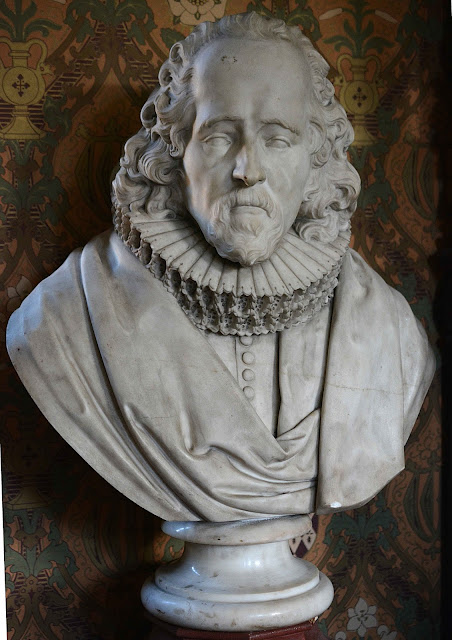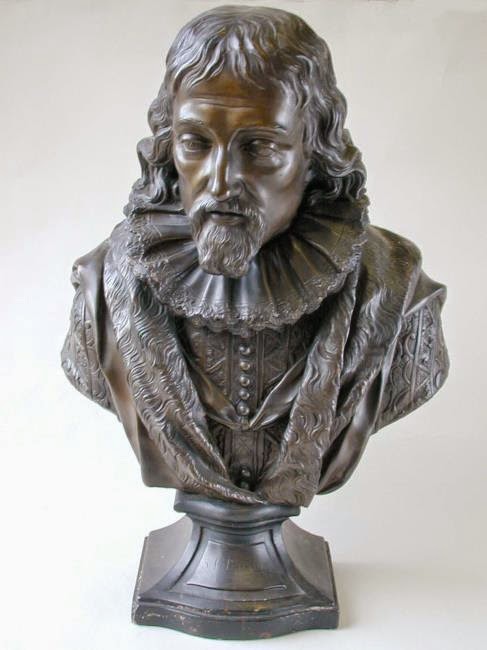Post under construction.
The Portrait Sculpture at Wilton House. Part 2.
I am very grateful to the 18th Earl and Countess of Pembroke for allowing me to visit with my camera and giving me free access to the sculptures outside visiting hours.
I am also very grateful to all the staff at Wilton, Charlotte Spender, Sandie Buxcie, and in particular the House Manager Nigel Bailey and all at Wilton who made me feel most welcome.
The Terracotta Bust of Francis Bacon (1561 - 1626). Lord Verulam.
by Louis Francois Roubiliac.
at Wilton House.
This is the prototype for both the Roubiliac bust of Bacon at the Wren Library, Trinity College, Cambridge, and the bust of Bacon in the Long Room at Trinity College Library, Dublin. -
It is unclear whether the Dublin bust is an autograph work by Roubiliac but was almost certainly from his studio.
There are some minor differences in these busts.
The modelling on the terracotta bust is superb, particularly in the detail of the hair, ruff and jerkin.
This bust has sustained substantial damage, some if not all in the firing and there is, as in the Pembroke terracotta evidence of overpainting probably to disguise the damage.
As in all the Roubiliac terracottas the head is hollow which lessened the risk of cracking. This is the French method, Michael Rysbrack's busts were generally solid and frequently have surface firing cracks which required his busts to be painted.
Both this bust and the bust of 8th Lord Pembroke have been stripped probably using a chemical stripper. this has left slightly oily patches on the surface - they now appear an almost bright orange which to me is not very pleasing but it does allow us to see the fine tool marks which are particularly obvious on the Bacon bust.
The Wilton House Guides.
James Kennedy 1758.
I can find no mention of the Bacon Bust although the busts of Fountain and Martin Folkes both by Roubiliac are mentioned.
https://archive.org/details/newdescriptionof00kenn/page/n7/mode/2up
The bust is mentioned in the 1769 Guide by James Kennedy A New Description...... page 65 situated on the Chimneypiece in the New Dining Room along with the bust of Thomas Earl of Pembroke and the bust of Isaac Newton - the bust of Newton has disappeared. This suggests that the bust of Newton was perhaps also a terracotta by Roubiliac.
https://archive.org/details/descriptionofpic00cowd/page/n1/mode/2up?q=Roubiliac
Francis Bacon (1561-1626); A Very Brief Biography.
Francis Bacon was a lawyer, statesman, philosopher, and master of the English tongue. He was born at York House off the Strand, London, the youngest son of the Lord Keeper, Sir Nicholas Bacon.
From 1573 to 1575 Bacon was educated at Trinity College, Cambridge, which goes some way to explain the presence of the Roubiliac bust of Bacon in the Wren Library at Trinity.
In 1576 he was admitted as an "ancient" (senior governor) of Gray's Inn, and he took up residence there in 1579. After becoming a barrister in 1582 he progressed and, in time, became a Queen's counsel extraordinary, solicitor general and attorney general.
In 1584 he sat as member of Parliament. He later
sought a post for himself in James I's services. He was appointed Lord Keeper
of the Great Seal in March 1617. The following year he was made Lord Chancellor
and Baron Verulam, and in 1620/21 he was created Viscount St. Albans. In 1618
he fell foul of George Villiers over the issue of the marriage of the daughter
of his old enemy, Sir Edward Coke, and fell from power.
The Gift of Daniel Lock.
This bust follows closely the terracotta at Wilton.
The Trinity College, Dublin Bust has some minor differences in the hair and dress but the socle with the panel on the front is the same.
All the busts at Trinity were photographed by the author in 2016.
I would like to thank Dr Nicolas Bell of the Wren Library, for facilitating the photography of the sculpture at the Wren Library.
The detail is the same as the Wilton terracotta and the Trinity College Wren Library Marble.
The shape of the socle and sharpness of the detail might suggest an 18th Century date.
Roubiliac certainly produced plaster casts of his work from at least 1738, when he sent casts of Handel to Sir James Harris, and busts of Alexander Pope and Bolingbroke for Lord Marchmont. There are no records of moulds or busts in his 1762 posthumous sale.
Images from Art UK website.
Until now the only known copy of a catalogue of the output
of Charles Harris is that in the National Arts Library at the Victoria and
Albert Museum - it is undated and in English.
The style of the socle with eared support suggests perhaps Pietro Sarti (1793 - 1868).
see for instance -
https://bathartandarchitecture.blogspot.com/2021/02/the-sarti-busts-at-wimpole-hall.html
http://www.victorianweb.org/sculpture/athenaeum/catalogue.html
Ex Collection Peter Hone.
Previously Bellmans Auctioneers, previously Sotheby's.
.................
For Sarti see - https://www.npg.org.uk/collections/research/programmes/british-bronze-founders-and-plaster-figure-makers-1800-1980-1/british-sculpture-makers-s
For the Shouts see - https://www.npg.org.uk/collections/research/programmes/british-bronze-founders-and-plaster-figure-makers-1800-1980-1/british-sculpture-makers-s#SH
...............................
Medallion by Dassier.
1733.
4.1 cms.
https://www.britishmuseum.org/collection/object/C_G3-IP-200
for more on the Dassier medallions see my previous post -
https://bathartandarchitecture.blogspot.com/2015/10/medallions-of-english-worthies-by-jean.html
........................
Portraits of Francis Bacon
Francis Bacon.
Paul van Somer (c. 1576-1621).
Łazienki Palace, Warsaw. Poland
Another full length probably contemporary version.
https://www.npg.org.uk/collections/search/portrait/mw00261/Francis-Bacon-1st-Viscount-St-Alban
..........................
Francis Bacon.
Engraving Crispijn de Passe the younger.
c. 1617 - 30.
British Museum
https://www.britishmuseum.org/collection/object/P_P-1-62
Note the similarities here with the bust by John Cheere (see images below)
..........................
Francis Bacon.
Étienne Desrochers.
French Engraving
c. 1720 - 40.
https://www.britishmuseum.org/collection/object/P_1853-0112-2027
.......................
Francis Bacon Engraving.
After Paul van Somer I (1576/1578–1622).
George Vertue.
1728.
............................................
Roubiliac almost certainly used this engraving to produce the Wilton Terracotta of Francis Bacon.
Francis Bacon
George Vertue.
Engraving after van Somer.
1734.
Image courtesy British Museum.
........................................
Francis Bacon.
Engraving from a Painting in the possession of Martin Folkes by John Vanderbank
1738.
Print made by: Jacob Houbraken.
Published by: John and Paul Knapton.
After:
British Museum
https://www.britishmuseum.org/collection/object/P_1927-1126-1-7-5
.................
A Marble Bust of Francis Bacon
by John Bacon the Elder (1740 - 99).
After Louis Francois Roubiliac.
1796.
Private Collection.
I am very grateful to the owners for providing these photographs.
..........................
The Marble Bust of Francis Bacon (1561 - 1626).
The first mention of a bust of Locke by Baily after Roubiliac is in Christie's Sale - Robert Vernon Esq. 5 July 1849. Lot 101 - £45.13 Bought Sir G Sergeller (?)
The two busts of Locke and Bacon by Hodges Bailey after
Roubiliac are noted as being in the Library at Magdalen College in 1866 in The
Eclectic Magazine of Foreign Literature, Science... Vol. 4; vol.67.
There is a marble bust of Newton by Hodges Bailey copied from the bust by
Roubiliac in the Wren Library now in The National portrait Gallery - it differs
slightly from the original in detail (as do both of these busts) in that the
sculptor has omitted the inner chemise. It is also dated 1828 (see below).
___________________
In 1839 he won the commission to carve the statue of Admiral Lord Nelson for the top of the column in Trafalgar Square, the work for which he is best remembered.
For a more in depth biography see
I would like to thank, Sir David Clary, Lady Heather Clary and Rachel Mehtar at Magdalen
College Oxford. and Stephen Hebron of the Weston Library, Oxford for allowing
me to visit and to photograph the busts under their care.
.................
The Royal Collection Marble Bust of Francis Bacon.
After Roubiliac
Here suggested as by Edward Hodges Bailey.
The detailing follows closely that on the Wilton terracotta and the TWren Library Marble.
....................................
The Plaster Busts of Francis Bacon by sculpted in the workshop of John Cheere
at Hyde Park Corner and the copies of the Cheere bust by Shout of Holbourn.
Robert Shout 1760 - 1843.
The Kirkleatham Bronzed Plaster Bust of Bacon.
Cast by John Cheere.
It uses the typical Cheere type panelled socle.
Perhaps the invention of John Cheere or someone in his workshop - very loosely based on the Roubiliac bust.
Height 56 cms.
Supplied by Cheere in 1749 to Cholmley Turner (1685 - 1757) of Kirkleatham Hall, Yorkshire.
The house was demolished in the 1950's
One of a series of 9 busts and 10 statuettes supplied by John Cheere.
Purchased at the Kirkleatham Sale of 1951.
Now with York Museums.
This bust should be compared with the bust as supplied to Wedgwood and Bentley by Hoskins and Grant (see below). The Wedgwood bust has an eared socle.
It appears that Hoskins and Grant had use of the original mould or had perhaps pirated the bust by John Cheere. This needs to be clarified!
.............................
The Wedgwood Busts in the Wedgwood Collection at the V and A.
..........................
Wedgwood Collection V and A.
The Base of Another Bust of Bacon
NB Round Socle and three buttons and shortened trunk.
The website gives o size or date but it has the three buttons as in the Wedgwood basalt bust without socle (above).
https://collections.vam.ac.uk/item/O1406957/bust/
........................
Presumably the head from the above Bust
......................
The Hughenden Manor Plaster Bust.
Adapted from the original from the workshop of John Cheere.
Note longer trunk and the eight buttons on the front.
inscribed on reverse 'BACON R SHOUT HOLBOURN'.
Shout were in business by 1785.
The earliest catalogue/list of their stock is probably of about 1815.
Height 54 cms.
On long-term loan to Sudbury Hall in 1983 from Hughenden
Manor.
Hughendon was the country home of Benjamin Disreali.
https://www.nationaltrustcollections.org.uk/object/652362
Signed on reverse 'Michl. Rysbrack 1755'.
Obviously derived from the van Somer portrait.
This is one of eight busts of British worthies made by Rysbrack for Sir Edward Littleton's new house, Teddesley Hall near Stafford (now demolished), when he was furnishing it in neo-classical style. They essentially comprised four pairs: Raleigh (SCU0043) and Bacon, Shakespeare and Pope, Cromwell (SCU0014) and Milton, and Newton and Locke.
A description of the pictures, statues, busto's
basso-relievo's, and other curiosities at the Earl of Pembroke's house at
Wilton. The antiques of this collection contain ... Richlieu's and ...
Mazarine's, and ... Earl of Arundel's; ... By Richard Cowdry. 1751.
The 1752 Edition also available online.
https://www.jstor.org/stable/community.35013350?seq=11
A New Description of the Pictures, Statues, Bustos, Basso-relievos, and other curiosities at the Earl of Pembroke's house at Wilton. In the antiques of this collection are contain'd the whole of Cardinal Richelieu's and Cardinal Mazarine's, and the greatest part of the Earl of Arundel's; besides several particular pieces purchas'd at different times. 1758. James Kennedy.
https://archive.org/details/newdescriptionof00kenn/page/n7/mode/2up?q=Hall
Both the following are very outdated and cannot be entirely relied upon.
Roubiliac’s work at Trinity College Cambridge. Esdaile, K.A
Recently digitalised - and available online at https://digi.ub.uni-heidelberg.de/diglit/esdaile1928









































































%20Shout%20adj.jpg)
adj.jpg)
%20adj.jpg)







No comments:
Post a Comment